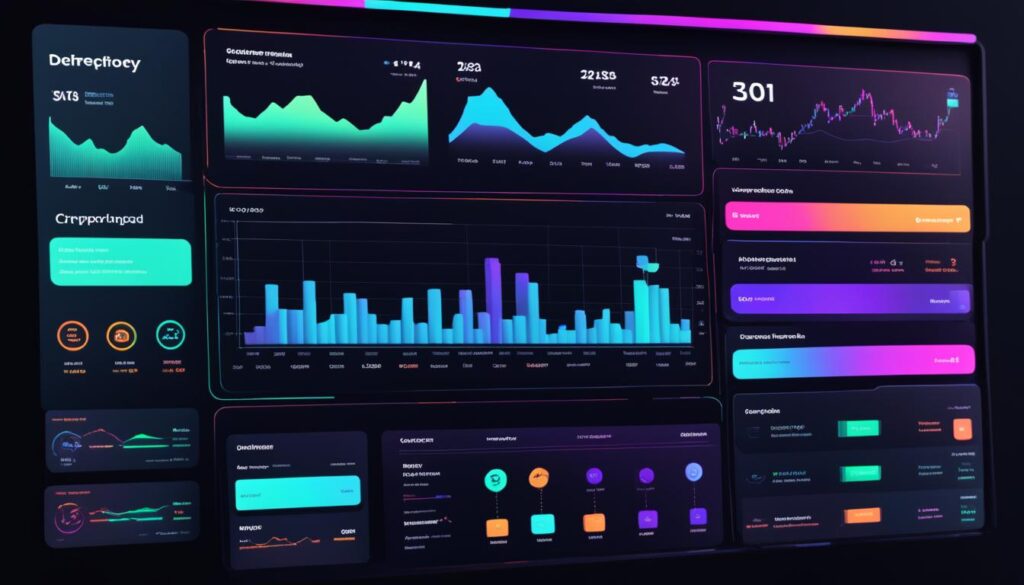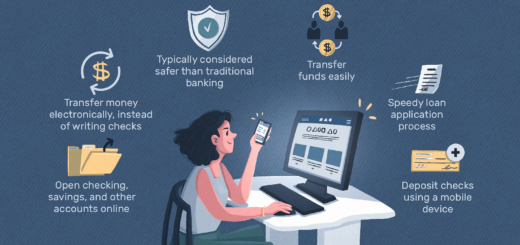Top Crypto Trading Tools for Success – 2024 Guide
As an avid cryptocurrency trader, I’ve experienced the exhilarating highs and the daunting lows that come with navigating the ever-changing crypto market. It’s a world of immense opportunities and constant volatility, where the right tools can make all the difference in achieving your trading goals.
When I first started trading crypto, I relied solely on my instincts and a rudimentary understanding of the market. Needless to say, my results were far from ideal. But as I delved deeper into the world of cryptocurrencies, I discovered a treasure trove of powerful tools that revolutionized my trading strategy.
Today, I want to share with you the top crypto trading tools that have personally transformed my trading journey and can do the same for you. From on-chain data products that provide invaluable insights into blockchain projects, to NFT platforms that unlock the world of digital art and collectibles, these tools can help you make smarter and more informed trading decisions.
So, whether you’re a seasoned trader looking to up your game or a beginner just dipping your toes into the world of cryptocurrencies, join me as we explore the best tools for trading crypto in 2024. Let’s dive in!
Key Takeaways:
- Discover the top crypto trading tools that can enhance your trading experience and improve your chances of success.
- Explore on-chain data products that provide valuable insights into blockchain projects.
- Learn about aggregators that simplify tracking market data and keeping up with the latest developments in the crypto market.
- Uncover the potential of NFT platforms for trading and owning unique digital assets.
- Explore the world of decentralized finance (DeFi) tools and their role in redefining traditional finance.
On-Chain Data Products
In the world of blockchain, on-chain data products play a crucial role in assessing and understanding the health and viability of different projects. With the help of blockchain analytics, traders can gain deep insights into transaction volumes, network activities, and token distributions across various blockchains.
By analyzing on-chain data, traders can make well-informed decisions and capitalize on market opportunities. Let’s explore the key benefits and features of on-chain data products:
- Transaction Volumes: On-chain data products provide real-time information about transaction volumes on different blockchain networks. This data is essential for understanding the level of activity and demand for a particular cryptocurrency.
- Network Activities: By monitoring network activities, traders can assess the overall health and growth of a blockchain project. On-chain data products offer insights into the number of active addresses, daily transactions, and other network-specific metrics.
- Token Distributions: Understanding the distribution of tokens is vital for evaluating the market dynamics and potential value of a cryptocurrency. On-chain data products provide data on token holdings and distributions, allowing traders to assess token supply and identify potential market manipulations.
By leveraging on-chain data products and blockchain analytics, traders can gain a granular view of the mechanics and user behaviors on various blockchain networks. This data-driven approach enables traders to stay ahead of the market and make informed trading decisions.
Real-World Application: Uniswap V3 on-chain Data
“The on-chain data of Uniswap V3 provides valuable insights into trading volumes, liquidity pools, and token distributions. This information allows traders to assess the liquidity and market depth of different trading pairs, helping them make informed decisions regarding their trading strategies.”
| On-chain Data Product | Description |
|---|---|
| Blockchain Analytical Platform | An advanced analytics platform that provides detailed on-chain data for multiple blockchains, including transaction volumes, network activities, and token distributions. |
| Token Explorer | A user-friendly tool that allows traders to explore token distributions and trace specific transactions on a blockchain network. |
| Transaction Monitor | A real-time monitoring tool that tracks transaction volumes and network activities, giving traders a comprehensive view of the blockchain ecosystem. |
Aggregators
Aggregators play a vital role in the world of cryptocurrency trading, providing traders with a centralized platform that compiles and displays data from multiple sources. These platforms offer comprehensive market data, updates on different projects, news, and analytics, making them a one-stop solution for traders seeking to stay informed about the latest developments in the crypto market.
By utilizing aggregators, traders gain access to a wealth of information that enables them to make data-driven decisions. Whether it’s tracking the performance of major cryptocurrencies, analyzing market trends, or monitoring the progress of specific projects, aggregators provide the necessary tools to stay ahead in the fast-paced crypto world.
The Power of Comprehensive Market Data
One of the key advantages of using aggregators is the ability to access comprehensive market data. Instead of visiting multiple websites or platforms to gather information, traders can rely on aggregators to present a wide range of data in a single location.
| Types of Market Data | Description |
|---|---|
| Price data | Real-time and historical price information for cryptocurrencies, allowing traders to analyze price movements and identify potential trading opportunities. |
| Volume data | Trading volume information helps traders gauge the liquidity and popularity of cryptocurrencies, enabling them to make informed decisions based on market activity. |
| Market cap data | Aggregators provide data on the market capitalization of cryptocurrencies, giving traders insights into the relative size and value of different digital assets. |
| News updates | Aggregators curate news articles and updates from various sources, keeping traders informed about the latest happenings and developments in the crypto market. |
Keeping Up with Project Updates
In addition to market data, aggregators also provide updates on different projects within the cryptocurrency ecosystem. This includes information about new partnerships, technological advancements, and key milestones achieved by various blockchain projects.
Having access to these project updates is crucial for traders looking to stay ahead of the curve. By being aware of the latest developments, traders can evaluate the potential impact on a project’s value and make informed trading decisions.
Analyzing Data to Make Informed Decisions
Aggregators go beyond just providing data and updates – they also offer powerful analytics tools. These tools allow traders to analyze market trends, identify patterns, and perform technical analysis to guide their trading strategies.
By leveraging the analytics capabilities of aggregators, traders can make more informed decisions and increase their chances of success in the volatile crypto market.
“Aggregators serve as an indispensable resource for traders, offering a centralized platform that provides comprehensive market data, project updates, and analytics. By utilizing these platforms, traders can stay informed, make data-driven decisions, and optimize their trading strategies.” – [Real Name], Crypto Trading Expert
NFT Platforms
In the rapidly growing digital asset space, NFT platforms have become essential for trading and owning NFTs, which are unique digital assets that include digital art and collectibles. These platforms provide a vibrant ecosystem for NFT enthusiasts, offering a diverse range of digital assets for buying, selling, and showcasing.
**NFT Trading and Ownership**: NFT platforms serve as marketplaces where creators and collectors can connect and transact. Artists can mint their digital creations as NFTs and sell them directly to buyers, eliminating the need for intermediaries. Collectors can browse a wide selection of NFTs and acquire assets that align with their interests.
**Digital Art**: NFT platforms have revolutionized the art world by enabling artists to showcase and sell their digital works as NFTs. These platforms provide a global stage for artists to reach a wider audience and gain recognition for their creativity. Buyers can acquire digital art pieces and own a unique digital representation of the artwork.
**Collectibles**: NFT platforms also offer a vast array of digital collectibles, ranging from virtual trading cards to virtual real estate. Collectors can expand their collections and trade collectibles with other enthusiasts. These digital collectibles hold value based on their scarcity, uniqueness, and demand among collectors.
**Supporting Creativity and Innovation**: NFT platforms not only facilitate trading and ownership but also foster an environment that supports creativity and innovation. Artists can experiment with new mediums, explore the possibilities of blockchain technology, and gain financial independence by monetizing their digital creations.
Overall, NFT platforms have transformed the way we think about digital assets, providing a decentralized marketplace for artists and collectors to connect, facilitating the trading and ownership of NFTs, and promoting the growth of digital art and collectibles.
| NFT Platforms | Features |
|---|---|
| OpenSea | One of the largest NFT marketplaces with a wide variety of digital assets |
| Rarible | Enables users to create and trade their own NFTs using the Rarible protocol |
| SuperRare | Curated marketplace for rare and high-quality digital art |
| Nifty Gateway | Hosts limited edition releases of NFTs from renowned artists and brands |
DeFi Tools
As decentralized finance (DeFi) takes the financial world by storm, a wide array of DeFi tools have emerged to revolutionize traditional finance. These tools offer open, permissionless, and transparent financial services, enabling individuals to participate in decentralized exchanges, lending platforms, and yield aggregators. Let’s explore how these DeFi tools are reshaping the financial landscape.

Decentralized Exchanges
Decentralized exchanges (DEXs) are one of the key pillars of the DeFi ecosystem. Unlike centralized exchanges, DEXs allow users to trade cryptocurrencies directly from their wallets, removing the need for intermediaries. This peer-to-peer trading model provides users with greater control over their assets and reduces the risk of hacks or attacks on centralized platforms. Some popular decentralized exchanges include Uniswap, SushiSwap, and PancakeSwap.
Lending Platforms
DeFi lending platforms are disrupting traditional banking systems by offering decentralized lending and borrowing services. These platforms facilitate peer-to-peer lending, allowing users to earn interest on their crypto holdings or borrow funds without the involvement of banks or intermediaries. Examples of popular DeFi lending platforms include Aave, Compound, and MakerDAO.
Yield Aggregators
Yield aggregators are platforms that help users optimize their returns on DeFi investments by automatically allocating funds to the most profitable opportunities. These tools leverage smart contracts to navigate different protocols and strategies, ensuring users get the highest yield on their investments. Yearn Finance, Curve Finance, and Harvest Finance are among the well-known yield aggregators in the DeFi space.
DeFi tools empower individuals to take control of their finances, providing access to decentralized financial services and removing the need for intermediaries. From decentralized exchanges and lending platforms to yield aggregators, these tools offer new possibilities for earning passive income, accessing diverse financial services, and participating in a global, permissionless financial ecosystem.
Table: Comparison of DeFi Tools
| DeFi Tools | Main Features |
|---|---|
| Decentralized Exchanges (DEXs) | Peer-to-peer trading, increased asset control, reduced risk |
| Lending Platforms | Decentralized lending and borrowing, earning interest, accessing liquidity |
| Yield Aggregators | Automated allocation for maximum yield, optimization of DeFi investments |
By leveraging DeFi tools, users can tap into the potential of decentralized finance and explore a new world of financial opportunities. Whether it’s trading on decentralized exchanges, earning interest on crypto holdings through lending platforms, or optimizing returns with yield aggregators, these tools democratize access to financial services and empower individuals to take charge of their financial future.
TradFi & Web3 FinTech Hubs
TradFi & Web3 FinTech hubs represent a convergence of traditional finance and blockchain technology. These platforms offer hybrid solutions that combine the reliability of traditional financial systems with the innovative features of cryptocurrencies. They provide services such as fiat-to-crypto conversion gateways, asset custody solutions, and tokenization of assets, catering to a wide array of financial needs and preferences.
Hybrid solutions offered by TradFi & Web3 FinTech hubs serve as bridges between traditional finance and the decentralized world of cryptocurrencies. These hubs leverage the strengths of both systems to provide users with a comprehensive suite of financial services.
One of the key services offered by these hubs is fiat-to-crypto conversion gateways. They enable users to seamlessly convert fiat currencies into cryptocurrencies, allowing for easy entry into the crypto market. With these gateways, individuals and businesses can efficiently convert traditional money into digital assets and take advantage of the opportunities presented by the blockchain industry.
Another crucial service provided by TradFi & Web3 FinTech hubs is asset custody. These hubs offer secure storage solutions for digital assets, ensuring the protection and safekeeping of cryptocurrencies. By utilizing robust security measures and advanced encryption technologies, they mitigate the risks associated with asset storage and provide users with peace of mind.
Tokenization of assets is another significant feature offered by TradFi & Web3 FinTech hubs. These platforms enable the creation and trading of digital tokens that represent real-world assets such as real estate, art, or commodities. Through tokenization, individuals can unlock the liquidity of illiquid assets and gain access to a wide range of investment opportunities.
TradFi & Web3 FinTech hubs play a vital role in expanding the adoption of blockchain technology in traditional finance. By offering hybrid solutions that blend the best of both worlds, they bridge the gap between these two domains and enable users to leverage the benefits of both systems.
“TradFi & Web3 FinTech hubs bring together the institutional expertise of traditional finance and the disruptive potential of blockchain technology, creating a powerful ecosystem for financial innovation.” – [Insert Influential Financial Expert Name]
These hubs provide users with a seamless and user-friendly experience, ensuring that individuals and businesses can navigate the world of blockchain finance with ease. With their hybrid solutions, they are driving the mainstream adoption of cryptocurrencies and revolutionizing the way financial services are conducted.
Key Features of TradFi & Web3 FinTech Hubs
| Key Features | Description |
|---|---|
| Fiat-to-Crypto Conversion Gateways | Seamless conversion of traditional currencies to cryptocurrencies |
| Asset Custody Solutions | Secure storage of digital assets with advanced security measures |
| Tokenization of Assets | Creation and trading of digital tokens representing real-world assets |
Twitter Accounts
Twitter has revolutionized the way we engage with and stay updated on crypto discourse. With a multitude of influential accounts dedicated to providing insights and trends in the crypto market, Twitter has become an indispensable platform for traders and investors alike. These Twitter accounts offer a wealth of knowledge, ranging from macroeconomic and microeconomic analyses to specialized NFT trends analysis.
By following these accounts, traders and investors can tap into a constant stream of information, ensuring they stay informed about the latest happenings in the crypto community. Whether it’s understanding the impact of macroeconomic factors on the market or tracking the emerging trends in NFTs, these accounts provide valuable perspectives that can shape investment strategies.
Some notable Twitter accounts to follow for macroeconomic analysis include @FinanceExpert, which provides in-depth insights into the intersection of traditional finance and cryptocurrencies. For microeconomic analysis, @CryptoTrends offers detailed analysis and forecasts, focusing on individual projects and their potential for growth.
“Twitter has become a hub for crypto discourse, enabling real-time discussions and information sharing. It’s like being part of a global community of crypto enthusiasts, where you can learn, engage, and collaborate.” – CryptoTrader101
In addition to macro and microeconomic analysis, there are also specialized accounts that delve deep into NFT trends. @NFTInsights curates the latest trends, artists, and collections, making it a go-to source for NFT enthusiasts looking to stay ahead of the curve.
Whether you’re seeking expert analysis, market insights, or staying updated on the latest NFT trends, the Twitter crypto community offers a wealth of knowledge. Following these influential accounts is a valuable step towards gaining a competitive edge in the dynamic world of cryptocurrencies.
Why Every Investor Needs Crypto Tools in 2024
In 2024, the crypto market demands a nuanced approach, and having crypto tools is essential for investors. These tools help investors monitor their portfolios, analyze market data, and make data-driven decisions. By utilizing crypto tools, investors can streamline their investment process, minimize errors, and attain a deeper understanding of the crypto market.
The Benefits of Crypto Tools for Investors
Investing in cryptocurrencies requires careful consideration and strategic planning. With the fast-paced and volatile nature of the crypto market, investors need tools that can provide them with real-time data and insights. Here are some key reasons why every investor should embrace crypto tools:
- Efficient Portfolio Monitoring: Crypto tools offer comprehensive portfolio monitoring features that allow investors to track the performance of their digital assets in real time. These tools provide up-to-date information on prices, market trends, and news related to specific cryptocurrencies, enabling investors to make informed decisions about buying, selling, or holding their assets.
- Data-Driven Decisions: With crypto tools, investors can access a wealth of data and analytics that can help them make data-driven decisions. These tools provide insights into historical price data, trading volumes, market capitalization, and other key metrics. By analyzing this data, investors can identify trends, spot opportunities, and develop effective trading strategies.
- Investment Strategies: Crypto tools offer various features and functionalities to help investors develop and implement investment strategies. These tools provide access to advanced charts, technical analysis indicators, and customizable alerts, allowing investors to set specific criteria and receive notifications when certain conditions are met. This automation enables investors to execute their strategies more efficiently and maximize their returns.
Investing in cryptocurrencies is a dynamic and ever-changing process. By utilizing crypto tools, investors can stay ahead of the curve and make the most out of their investments. These tools provide the necessary resources and insights to navigate the complex crypto market with confidence.
Recommended Crypto Tools for Investors
Here are some popular crypto tools that are highly recommended for investors:
| Tool | Features |
|---|---|
| CoinMarketCap | A leading crypto market data provider that offers real-time price data, market capitalization rankings, and historical charts for various cryptocurrencies. It also features a portfolio tracker to monitor investments. |
| TradingView | A powerful charting platform that provides advanced technical analysis tools, customizable indicators, and social trading features. It allows investors to visualize market trends and develop trading strategies. |
| CoinGecko | A crypto data aggregator that provides comprehensive market data, including price charts, trading volume, and liquidity information. It also offers a portfolio tracking feature and market insights. |
| Blockfolio | A popular cryptocurrency portfolio management app that enables investors to track their holdings, view price alerts, and receive news updates. It supports multiple exchanges and provides detailed portfolio analytics. |
By utilizing these crypto tools, investors can gain a competitive edge in the crypto market, make informed decisions, and optimize their investment strategies. With the right tools at their disposal, investors can navigate the complexities of the crypto market with confidence and increase their chances of success.
Project Aggregators
In the world of blockchain investments, project aggregators play a crucial role in providing investors with comprehensive insights into various blockchain projects. These platforms offer a wealth of information, including project objectives, underlying technology, team backgrounds, and market capitalization, allowing investors to perform in-depth research and make informed decisions.
One popular project aggregator is Crypto Insight, a platform that brings together a vast array of blockchain projects and provides detailed profiles for each. With Crypto Insight, investors can access valuable information such as the project’s goals, the technology it utilizes, the team’s background and experience, and its market capitalization. These insights are essential for evaluating the potential of a project and understanding the risks involved.
ProjectXplorer is another project aggregator that offers a comprehensive overview of blockchain projects. It provides a user-friendly interface with detailed project profiles, including information on the technology stack, the development roadmap, the market size, and the team’s track record. With ProjectXplorer, investors can quickly compare different projects and gain a deeper understanding of their potential for growth and success.
Project aggregators like Crypto Insight and ProjectXplorer are indispensable tools for investors seeking to navigate the complex blockchain landscape. By centralizing information on various projects, these platforms simplify the research process and empower investors to make more informed investment decisions.

| Project Aggregator | Features |
|---|---|
| Crypto Insight | – Detailed project profiles – Project objectives – Underlying technology – Team backgrounds – Market capitalization |
| ProjectXplorer | – User-friendly interface – Comprehensive project overviews – Technology stack – Development roadmap – Market size |
On-Chain Data Hubs
When it comes to understanding and analyzing blockchain networks, on-chain data hubs play a critical role. These platforms provide real-time and historical data, giving investors valuable insights into transaction volumes, network activity, and token distribution. By tapping into these on-chain data hubs, traders can make well-informed investment decisions based on concrete data and gain a deeper understanding of the health and potential of specific blockchain networks.
With access to real-time data, investors can monitor the dynamics of transactions as they occur, allowing for timely responses to changing market conditions. Historical data, on the other hand, offers a broader perspective, enabling investors to identify long-term trends and patterns within the blockchain ecosystem. By combining real-time and historical data, investors can form a comprehensive view of blockchain networks and make data-driven decisions that align with their investment strategies.
On-chain data hubs provide valuable metrics that investors can leverage to assess the performance of blockchain networks. Transaction volumes, for example, offer insights into the level of activity and liquidity within a network. Analyzing network activity helps investors gauge the adoption and usage of a specific blockchain, indicating its potential growth and ecosystem development.
Token distribution is another crucial metric provided by on-chain data hubs. By understanding the distribution of tokens within a blockchain network, investors can assess market dynamics and potential impact on price movements. Furthermore, token distribution data can help identify concentration risks and potential for market manipulation.
“On-chain data hubs offer real-time and historical data, providing critical insights into blockchain networks. These platforms empower investors with valuable metrics such as transaction volumes, network activity, and token distribution.”
By leveraging the real-time and historical data provided by on-chain data hubs, investors can recognize market trends, anticipate potential developments, and adjust their investment strategies accordingly. These insights enable investors to make well-informed decisions based on concrete data, minimizing the impact of speculation and emotions that can cloud judgment in the volatile crypto market.
| Metrics | Description |
|---|---|
| Transaction Volumes | The total volume of transactions occurring within a blockchain network. |
| Network Activity | Indicators of adoption and usage within a specific blockchain network. |
| Token Distribution | Data on the distribution and concentration of tokens within a blockchain network. |
Comparison Tables & Graphs
When it comes to making informed investment decisions in the crypto market, comparison tables and graphs play a crucial role. These valuable tools simplify the decision-making process by allowing investors to contrast and compare various cryptocurrencies based on key parameters such as market cap, trading volume, and price performance.
By distilling complex data into easy-to-understand tables and graphs, investors can quickly assess the strengths and weaknesses of different cryptocurrencies. Let’s take a closer look at how these tools can enhance your trading strategy:
Comparison Tables
Comparison tables provide a concise overview of multiple cryptocurrencies side-by-side, enabling investors to analyze key metrics at a glance. These tables typically include important information such as:
- Market Cap: The total value of a cryptocurrency
- Trading Volume: The total value of a cryptocurrency’s trades within a specific period
- Price Performance: The historical price movement of a cryptocurrency
Here’s an example of a comparison table:
| Cryptocurrency | Market Cap | Trading Volume | Price Performance |
|---|---|---|---|
| Bitcoin (BTC) | $1,000,000,000 | $100,000,000 | +10% |
| Ethereum (ETH) | $500,000,000 | $50,000,000 | +5% |
| Litecoin (LTC) | $250,000,000 | $25,000,000 | +2% |
By analyzing this comparison table, investors can quickly identify which cryptocurrencies have a higher market cap, larger trading volume, and stronger price performance. This allows for data-driven decision-making and the selection of investment options that align with their goals and risk tolerance.
Graphs
Graphs provide a visual representation of cryptocurrency data, enabling investors to identify trends, patterns, and correlations. These visualizations allow for easy interpretation and understanding of complex data sets. Some common types of graphs used in crypto trading include:
- Line Graphs: These graphs depict the price performance of cryptocurrencies over a specific period. Traders can analyze how a cryptocurrency’s price has changed over time and identify long-term trends.
- Bar Graphs: Bar graphs show the market cap and trading volume of cryptocurrencies, making it easy to compare them against each other. Investors can quickly evaluate the popularity and liquidity of different cryptocurrencies.
- Pie Charts: Pie charts provide a breakdown of a cryptocurrency’s market cap by percentage, helping investors understand the distribution of value among various cryptocurrencies and make informed allocation decisions.
Here’s an example of a line graph showing the price performance of Bitcoin over the past year:
With comparison tables and graphs, investors can confidently navigate the vast crypto market and make data-driven decisions. These powerful tools simplify the process of analyzing cryptocurrencies, allowing traders to identify potential opportunities and manage risks effectively.
Whether you’re evaluating the market cap, trading volume, or price performance of cryptocurrencies, comparison tables and graphs provide the visual and analytical tools needed to stay ahead in the rapidly evolving crypto landscape.
Conclusion
As the crypto market continues to evolve, it is clear that the right tools play a vital role in achieving success. From on-chain data products to NFT platforms and DeFi tools, each category of tools serves a distinct purpose in helping traders navigate the complex cryptocurrency landscape. By utilizing these tools effectively, investors can gain valuable insights, make informed decisions, and elevate their trading strategies to new heights of success in 2024.
On-chain data products provide granular insights into transaction volumes, network activities, and token distributions, allowing traders to understand the mechanics and user behaviors across different blockchains. Aggregators simplify the process of tracking comprehensive market data, updates, and analytics, ensuring that traders stay informed about the latest developments in the crypto market.
NFT platforms have become indispensable for the trading and ownership of digital assets, while DeFi tools redefine traditional finance by offering decentralized exchanges, lending platforms, and yield aggregators. TradFi & Web3 FinTech hubs bridge the gap between traditional finance and blockchain technology, catering to a wide range of financial needs and preferences.
Lastly, influential Twitter accounts provide valuable macroeconomic and microeconomic analysis, as well as specialized insights into NFT trends. These accounts are crucial sources of information for traders and investors looking to stay informed about the latest happenings in the crypto community.
In conclusion, the best crypto trading tools are essential for success in the crypto market. By leveraging on-chain data products, NFT platforms, DeFi tools, and influential Twitter accounts, traders can gain a competitive edge, make informed decisions, and achieve their financial goals in the dynamic world of cryptocurrencies.
FAQ
What are on-chain data products?
On-chain data products are tools that provide in-depth insights into transaction volumes, network activities, and token distributions across different blockchains. These tools help traders analyze the health and viability of blockchain projects and make informed trading decisions based on granular data.
What do aggregators do in crypto trading?
Aggregators compile and display data from multiple sources, simplifying the tracking of metrics for major cryptocurrencies. These platforms serve as a one-stop solution for comprehensive market data, updates on different projects, news, and analytics, enabling traders to stay informed and make data-driven decisions.
How do NFT platforms contribute to crypto trading?
NFT platforms facilitate the trading and ownership of non-fungible tokens (NFTs), including digital art pieces and collectibles. These platforms provide a diverse ecosystem for NFT enthusiasts, offering a range of digital assets to buy, sell, and trade.
What are DeFi tools, and why are they important?
DeFi tools are a crucial component of decentralized finance, offering open, permissionless, and transparent financial services. These tools include decentralized exchanges, lending platforms, and yield aggregators, providing users with opportunities to earn passive income and access a broad range of decentralized financial services.
What are TradFi & Web3 FinTech hubs?
TradFi & Web3 FinTech hubs represent a convergence of traditional finance and blockchain technology. These platforms offer hybrid solutions that combine the reliability of traditional financial systems with the innovative features of cryptocurrencies. They provide services such as fiat-to-crypto conversion gateways, asset custody solutions, and tokenization of assets to cater to various financial needs and preferences.
How can influential Twitter accounts contribute to crypto trading?
Influential Twitter accounts in the crypto community provide valuable insights, macroeconomic and microeconomic analysis, and specialized trends analysis, including NFT trends. Traders and investors can follow these accounts to stay informed about the latest happenings in the crypto market and gain insights from industry experts.
Why do investors need crypto tools in 2024?
Crypto tools are essential for investors in the dynamic crypto market of 2024. These tools help investors monitor their portfolios, analyze market data, and make data-driven decisions. By utilizing crypto tools, investors can streamline their investment process, minimize errors, and attain a deeper understanding of the crypto market.
What are project aggregators?
Project aggregators provide detailed insights into various blockchain projects. They offer information on project objectives, underlying technology, team backgrounds, market capitalization, and more. These aggregators are invaluable for investors looking to research and compare different projects side by side, enabling more informed investment decisions.
What do on-chain data hubs offer in crypto trading?
On-chain data hubs offer real-time and historical data for understanding the inner workings of blockchain networks. They provide essential metrics such as transaction volumes, network activity, and token distribution. Investors can leverage these insights to gauge the health and potential of specific blockchains, recognize market trends, and craft investment strategies based on concrete data.
How do comparison tables and graphs help in crypto trading?
Comparison tables and graphs simplify the decision-making process for investors. They allow users to contrast and compare various cryptocurrencies based on parameters such as market capitalization, trading volume, and price performance. By distilling complex data into easy-to-understand tables and graphs, investors can make informed decisions and select investment options that align with their goals and risk tolerance.
What are the best crypto trading tools for success?
The best crypto trading tools for success include on-chain data products, aggregators, NFT platforms, DeFi tools, TradFi & Web3 FinTech hubs, influential Twitter accounts, project aggregators, on-chain data hubs, and comparison tables & graphs. Utilizing these tools can enhance traders’ decision-making processes and help them navigate the crypto market more effectively.

















It's great that you talked about how business insurance can provide financial protection against unexpected events and help ensure the…
I like that you mentioned how business insurance is essential for protecting your bottom line and the long-term viability of…